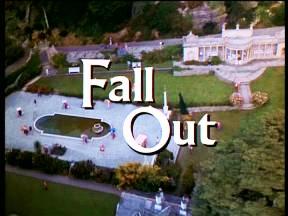 Fall Out
Fall OutTransmission Date: 2/2/1968
Episode Length: 49'01m (DVD timing)/50'59m (Blu-Ray timing)
Est. Ratings: 9.8m
Written by: Patrick McGoohan (With additional material by Kenneth Griffith, uncredited)
Directed by: Patrick McGoohan
DVD availability: Try amazon.com
Production Commenced:
December 1967
Production Credits:
An ITC Production by Everyman Films Ltd. Producer: David Tomblin; Production Manager: Ronald Liles; Director of Photography: Brendan J. Stafford B.S.C.; Art Director: Jack Shampan; Camera Operators: Len Harris, Bob Kindred; Editor: Noreen Ackland G.B.F.E., Eric Boyd-Perkins G.B.F.E.; Theme: Ron Grainer; Musical Director: Albert Elms; Assistant Director: Gino Marotta; Sound Editor: Will Thompson; Sound Recordist: Cyril Swern; Music Editor: Eric Mival; Casting Director: Rose Tobias-Shaw; Set Dresser: John Lageu; Continuity: Phyllis Townshend; Make-Up: Frank Turner; Hairdressing: Olive Mills and Wardrobe: Dora Lloyd. Made in the grounds of the Hotel Portmerion, Penrhyndeudraeth, North Wales by courtesy of Mr. Clough Williams-Ellis and at Metro-Goldwyn-Mayer Studios, Borehamwood, England.
Starring:
Patrick McGoohan (The Prisoner); Alexis Kanner (Number Forty Eight); Leo McKern (Number Two); Kenneth Griffith (The President); Angelo Muscat (The Butler); Peter Swanwick (The Supervisor); Michael Miller (The Delegate) and Roy Beck (Machine Gunner, uncredited)
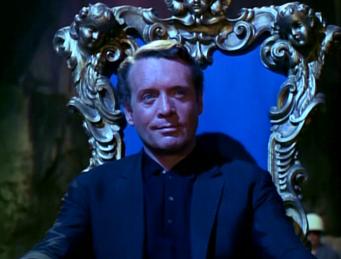
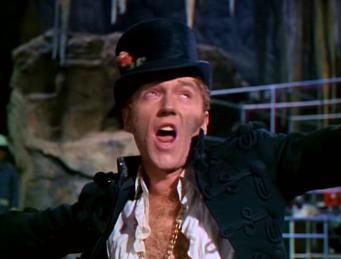
No.6:
No.6 is given his old suit back and permission to leave - or lead - the Village. He is also given the key to his house, a million travellers cheques, a passport valid for anywhere and petty cash.
In The Village:
The whole of the episode takes place down a further level of the Village underground. A row of jukeboxes (playing "All You Need Is Love" by The Beatles) line a corridor to the underground chamber, which ends in a door marked "Well Come". We see an assembly of Villagers who dress in cloaks and black and white masks. Each of them has a designation, and some we see are: activists, defectors, education, entertainment, identification, nationalists, pacifists, recreation, reactionists, therapy, welfare and youngsters. The supervisor is a member of this assembly.
The No.2 from The Chimes of Big Ben/Once Upon A Time is brought back to life, or "resuscitated" as it is termed here. He demands to know how "it was done". "Was it the drink?" he queries. The President insists that the Village must have some secrets. We learn that this No.2 had associations with statesmen, royalty and politicians, helping to define policies. He was brought to the Village as a prisoner himself (something alluded to in Once Upon A Time) and rues "that I resisted for so short a time". At the end of the episode he returns to the Houses of Parliament.
Rover:
Perhaps sadly, Rover emerges from the sea and into the underground chamber where he is destroyed in the burn-up of No.1's rocket.
Storyline:
No.6 is treated to an inaugural address, during which he witnesses the trial of two rebellious spirits: No.48 and a resurrected No.2. He gives an address to the assembly (interrupted as the assembly chants "I, I, I" in succession) and then has the opportunity to meet No.1.
Escape:
No.6 meets No.1. He pulls off his mask to reveal that of a chattering ape. Then he pulls off the ape mask to reveal... his own face.
He locks No.1 in his rocket and blasts it into space. Then he escapes from the Village by shooting his way out with No.2, No.48 and the butler. Together they escape in the detachable lorry (seen in "Once Upon A Time") and crash through an underground tunnel. One of the first few things we see after this is a sign for the A20, with London 27 miles away.
The Village has been evacuated, and, after dropping off two of his travelling companions, No.6 returns home with the butler. As he drives away, the door to his home opens automatically...
Trivia:
With all the major stories concerning The Prisoner, many myths have been passed down. Seemingly over a dozen people have taken credit for the invention of Rover, and there are many tales of this story's inception. Certainly, we know it was written in a short space of time - allegedly 48 hours - and that Kenneth Griffith had to supply much of his own dialogue, uncredited. However, do we believe the story that McGoohan told Alexis Kanner how it would end in bar one night, boasting how he would finish it by having a machine-gun breakout? Or that the script was still being dictated from McGoohan�s make up chair? Or Alexis Kanner's other claim that the series was to continue with No.48 and The Butler outside the Village, Pat taking a behind-the-camera role only?
This is also the shortest episode of The Prisoner. Though its full length makes it longer than any other episode, this includes three and half minutes of recap material from Once Upon A Time. The title sequence is absent, instead the episode title (but not the series' name) is overlayed onto an ariel shot of Portmerion. (Named here for the first and only time in the credits).
The sign of the estate agents preparing No.6's old home ("Lageu and Sons, Estate Agents, Auctioneers & Surveyors. Phone 546 0001 or 2") is an in-joke reference to Set Dresser John Lageu. Repeat screenings of this story on television insert the "slamming bars" ending to the episode, something which isn't in the original mastertape.
Dreams:
Some have theorised that the entire series is a dream of the lead character's. Taking this idea and consulting "dream interpretation" books, I found this may have some slight merit. Certainly, the constant usage of phallic imagery - including the key to his house, No.1's rocket and the penis extension that is the Lotus 7 - indicate a need for sexual liberation. (I'll say nothing of the book that indicates violence in dreams may be due to "passive homosexuality" - we've already done the "No.6 is gay" theory). The four men that escape are parts of No.6's subconscious. The butler, particularly, is No.6's underlying desire to serve others. This appears to be literally the driving force later in the dream, as he takes No.48, No.2 and No.6 through a tunnel ("The symbolic connection between the conscious and the unconscious", so the book says) in the lorry. There are other instances, such as the nature of Rover being an unconscious example of enlightenment. First McGoohan fights it, then at the end it is destroyed forever. Also, even the thunderclaps at the start of the episode have a "dream signifier"(?) They, apparently, represent "a warning voice from authority". However, it's truly doubtful McGoohan wrote and directed this episode for how it would match up in a "book of dream symbolism" from the local supermarket, but it's a nice idea...
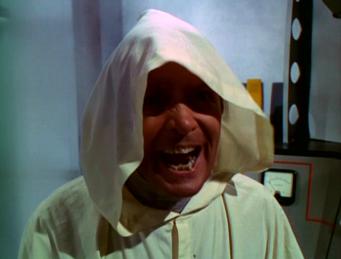
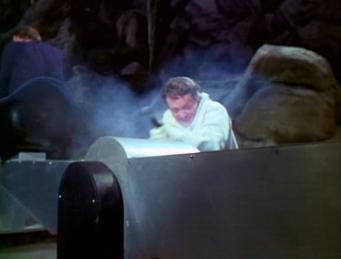
"You couldn't even let me rest in peace."
Viewpoint:
Fall Out is, of course, exactly the wrong way to end the series. Taking what started out as a fairly credible spy thriller and having it resolved only as allegory is a sure way to alienate and outrage viewers. Yet for those same reasons it�s exactly the right way to end it, and an episode that keeps the series alive.
Add to this a vibrant take on counterculture with sly drug references (�Thanks for the trip, dad�/�Now you�re high.�) and beautifully directed gun deaths to the tune of The Beatles. There�s even a singalong musical number in there, Leo McKern given one last roll of the dice and Pat hamming it up against his own dark reflection. It�s completely bonkers and completely brilliant.




